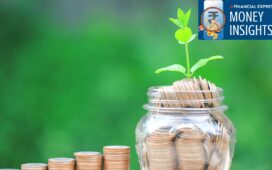It has been a boom year for investors. But now, as global stock markets continue to soar, top financial experts are warning bubbles may be forming that could cost ordinary investors thousands of pounds if they pop.
The US stock market is up over 11 pc, the world’s most valuable company Nvidia is up around 32 pc, and the gold price is up an impressive 56 pc. Growing numbers of investors are asking themselves how long this run can continue – and jitters are setting in.
On Friday Donald Trump’s move to ramp up his trade war with China, threatening even higher tariffs, led to a sell off in US and global stock markets. Shares were rising again yesterday, but the bigger fear is that investors have got carried away with the AI tech revolution.
Jemma Slingo, Pensions and Investment Specialist at Fidelity International says: ‘2025 has been a great year for investors so far –despite some bumps in the road.
‘Global stock markets have been climbing, and alternative assets such as gold and silver have soared in value. Nerves are setting in, however.’
Millions of ordinary investors will have benefited so far and will now be sitting on more valuable pension pots, bumper stocks and shares Isas and other investments as a result.
Kristalina Georgieva, Managing Director of the International Monetary Fund (IMF) warned last week that stock market valuations are heading towards levels seen during the dotcom internet bubble of 25 years ago.
Back then, the US stock market fell by 50 pc and it took years for some UK investors to make back their losses. Officials at the Bank of England made similar comparisons, warning last week that the risk has increased of a sharp market correction that could lose investors’ serious amounts of money.
It is notoriously difficult to spot a bubble while you’re in it. It is only really when a bubble bursts that you can be sure it ever existed.
And investors may miss out if they sell out of investments in the belief that a bubble could burst when in fact markets continue to rise. To help you decide if your investments are at risk, Money Mail ran the rule over popular investments that have surged in value in recent months – and asked experts to rate how likely it is that they are in ‘bubble’ territory.

The price of gold now exceeds $4,000 per troy ounce – an all-time high as investors turn to the asset class as a safe haven amid the US government’s shutdown, global conflicts, and tepid global economic growth
US stock market
The US stock market is now so large that it accounts for more than 70 pc of the value of all developed global markets combined.
If you own a global, tech or AI fund, you will have a large holding in US companies.
However, just because it is large doesn’t mean it is in bubble territory. What matters more is how fairly priced the shares are in companies that make up the US market.
There are lots of ways to value shares, but one of the most popular yardsticks is the price-to-earnings (PE) ratio. This tells you how much investors are willing to pay for every pound of profit a company delivers. If a company has a high PE ratio, it either means investors have great confidence in its ability to produce strong profits in the future – or that they are carelessly speculating and have got caught up in a wave of optimism.
To calculate it, you simply take a company’s share price and divide it by its earnings per share. But the PE ratio can also fluctuate a lot – Amazon has had a PE ratio as high as 935 but within the past few years it has stabilised at more ‘normal’ levels – currently 33 – as its earnings have become more substantial and predictable. Electric car giant Tesla’s PE ratio is now over 200, which many analysts think is ludicrous, while Comcast Corp, a media and tech company, has a low PE ratio of 5.
Using this formula, the US stock market (as measured by the S&P 500 index of 500 largest stocks) has a PE ratio of 23 times, which makes it look expensive.
By comparison, the UK’s FTSE 100 has a PE ratio of just 18.
Many investors prefer to use the ‘cyclically-adjusted price/earnings’ – or CAPE – ratio. All you need to know is that this is like the PE ratio but taking a ten-year average for the company’s earnings. A score of 10 or less is a low CAPE ratio, while 25 or more is high and could indicate a crash is brewing. Fidelity’s data suggests North America’s CAPE ratio is now approaching 40. It has been on an upward trajectory since 2009. Based on this metric, however, the US looks less at risk of a sharp fall than it did before the dotcom crash in 2000, when its CAPE ratio reached a massive 47.
However, even if the US stock market overall is not in bubble territory, there is still a risk that some of the biggest companies within it are.
Just seven technology companies are so valuable that they now make up around 34 pc of the value of the S&P 500. Known as the Magnificent Seven, these are Apple, Microsoft, Amazon, Alphabet, Meta, Nvidia and Tesla. Values have been soaring based on investors’ views that they still have huge potential – particularly as they harness the power of AI.
They are so much more valuable than all other companies around the globe that some have started to question if they are in bubble territory. In bubbles, a small number of stocks often rocket in value.
Iain Pyle, Senior Investment Director of Aberdeen Investments, says the biggest seven stocks in the S&P500 made up a much lower 22 pc of the index at the peak of the dotcom bubble in the early 2000s.’
Jemma Slingo, Pensions and Investment Specialist at Fidelity International, says: ‘So far, America’s biggest tech firms have kept delivering stellar growth.
‘If they stumble, however, shares have a long way to fall. Their financial results are due out this month and they will be studied very closely.’
Bubble-ometer score: 7/10
AI and tech companies
Technology companies are largely listed on the US Nasdaq index, which is up 15 pc so far this year. The value of many individual firms that comprise that index are up even more than that, including computer chip-maker Nvidia, cloud computing giant Oracle and Advanced Micro Devices, another chip-maker.
The recent rises have pushed the PE ratio of the Nasdaq to 33, and its CAPE ratio to 46. That means investors are taking a big bet on the money rolling in at US tech firms – and any wobble could precipitate a fall in share prices.
Wealth managers at Quilter warn there are far more tech firms on the Nasdaq with no profits or revenues today than in the past. It is a worrying sign if companies are valued highly when they have yet to turn a profit – it means they are unproven and valuations may be based on an optimistic view of their future earning-power.
Lindsay James, Investment Strategist at Quilter, says: ‘This clearly implies that there is a raised risk of a bubble in some areas of the market, but even if that is the case it gives no signal whatsoever about whether that could pop this week or years from now.’ While high, the PE ratio is still considerably lower than just before the dotcom bubble burst.
Pyle says the PE for the Nasdaq Index in March 2001 was a jaw-dropping 175.’
Shares in popular AI companies in particular have seen astronomical growth in recent months as investors bet on them emerging as winners in one of the most compelling trends of our time.
Chipmaker Nvidia is hitting all-time highs and is now worth an eye-watering $4.45 trillion (£3.5 trillion). Nvidia’s PE ratio is 51.
Bubble-ometer score: 8/10
Gold and gold miners
The price of gold now exceeds $4,000 per troy ounce – an all-time high – as investors turn to the asset class as a safe haven amid the US government’s shutdown, global conflicts, and tepid global economic growth.
There are many good reasons why prices have risen. Gold can offer protection against inflation and many governments have been buying it to reduce dependence on the US dollar. But, with no income, and few uses in the real world other than as decoration and a store of value, analysts say it is hard to pinpoint what a sensible price for gold really is.
Brian Dennehy, Managing Director at FundExpert, says: ‘There are many reasons to believe that the gold price could continue to rise. Ordinary investors have only this year started to buy more gold than they sell and their increased appetite for it could help push up the price. Shares in gold miners are still cheap so could rise further. However, the gold price is volatile. It wouldn’t be a shock if this advance had a breather, perhaps for a few months.’
Bubble-ometer score: 6/10

Jemma Slingo, pensions and investment specialist at Fidelity International
Silver/Copper/Platinum
Silver has outpaced gold so far this year, while copper is up around 20 pc. Ben Yearsley, Director of Fairview Investing, says: ‘If gold is in a bubble, then silver probably is as well.’
But the difference is silver has industrial uses, particularly in solar panels, which is a growth industry. Yearsley adds: ‘Copper is definitely not in a bubble. There is a massive structural shortage of it and if the move to electrify our energy supply continues then there is a massive deficit that will keep pushing up prices – good demand, not enough supply!’
Platinum demand is also tied to use in catalytic converters for combustion engines.
Pyle says: ‘The market has been weak due to concerns over electric vehicles replacing internal combustion engines but recent forecasts show slower EV adoption outside China and a stronger role for hybrids, which still require platinum metals.’
Bubble-ometer score: 4/10
Cryptocurrency
Major cryptocurrencies such as Bitcoin, Ethereum, BNB, Solana and Dogecoin have seen significant price rises – and plenty of dips along the way – throughout 2025. Bitcoin notably hit a record of $125,000 earlier this month.
There are plenty of reasons why values could continue to climb.
Cryptocurrency is increasingly taken seriously by governments worldwide and by investors – even some large asset managers are buying Bitcoin to add to their portfolios.
Regulation is also becoming friendlier towards cryptocurrencies, which is making it easier for ordinary investors to buy it and pushing up demand.
For example, as of last week UK investors can now hold funds comprised of a basket of cryptocurrencies within their tax-free Isas and pensions.
These funds, called Exchange-Traded Notes (ETNs), will be available to buy on investing platforms and will make it easier for investors to reduce their risk by holding a range of cryptocurrencies rather than buying them separately.
However, cryptocurrencies are highly susceptible to major swings in value and the risk of a sharp plunge is always there – especially after a spell of soaring prices.
Bitcoin is up by 19 pc so far this year, but down by over 8 pc since late last week. It doesn’t help that cryptocurrencies do not have any intrinsic value so it is hard to establish what the correct price should be.
Bubble-ometer score: 9/10
Property
The property market is still defying the gloom-mongers and is continuing on an upwards trajectory.
Even fears that the Budget next month could include measures that dampen the market have failed to dent prices by much. The cost of a typical home fell by just £794 to £298,184 last month, and rose by 0.2 pc in August.
However, it’s not all one-way traffic in the property market. Adrian Murphy, CEO of Murphy Wealth, says: ‘For many people the buy-to-let dream is over, with tax and policy changes making it much less viable as an investment proposition.’
That could weaken some areas of the market, pushing down prices. Even so, property analysts say there is a huge amount of latent demand for housing and nowhere near enough stock coming through to absorb it.
Bubble-ometer score: 2/10
Should you worry about a bubble?
Advisers say that if you have many years to go before you need your money, then you have time to weather stock market storms.
But if you need the money soon for retirement then the stakes are higher. Dennehy says: ‘From the perspective of UK-based investors, never has a generation of investors been so exposed to such risks at the most vulnerable point of their lives – the Boomers haven’t got time to go around the block and rebuild their wealth.
‘It took 16 years to recover losses from the 2000 Tech Bubble.’
However, just because some experts warn we may be in bubble territory, there is no guarantee that we are.
There is no strict definition of ‘bubble’ and the word gets thrown around far too often, says Tom Bailey, Head of Research at investment firm HANetf.
‘Most of the time it’s just another way of saying prices have gone up a lot, which isn’t very helpful.’ He adds: ‘Even economists can’t agree on what a bubble really is.’
Major banks have also warned about bubbles before and got it wrong in the past. Paul O’Neill, Chief Investment Officer at wealth manager Bentley Reid, says: ‘When Chairman of the Federal Reserve, Alan Greenspan, said in December 1996 that the markets were displaying signs of “irrational exuberance”, on many objective measures he was right.
‘The only problem was that over the next three years the main US stock market doubled.’
Another problem is that bubbles are only really recorded after they have popped.
Alastair Laing, Chief Executive at CG Asset Management, says: ‘It is most easily recognised in retrospect, where investors look back on an episode with a sick feeling in their stomach and ask, “What was I thinking?” ’



